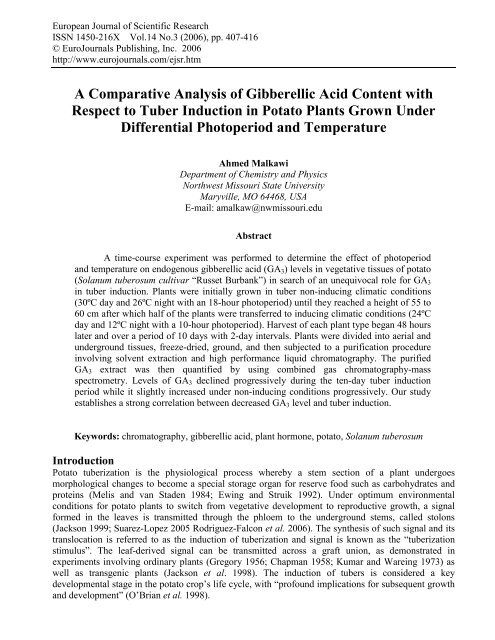European Journal of Scientific Research - EuroJournals
European Journal of Scientific Research - EuroJournals
European Journal of Scientific Research - EuroJournals
Create successful ePaper yourself
Turn your PDF publications into a flip-book with our unique Google optimized e-Paper software.
<strong>European</strong> <strong>Journal</strong> <strong>of</strong> <strong>Scientific</strong> <strong>Research</strong><br />
ISSN 1450-216X Vol.14 No.3 (2006), pp. 407-416<br />
© Euro<strong>Journal</strong>s Publishing, Inc. 2006<br />
http://www.eurojournals.com/ejsr.htm<br />
A Comparative Analysis <strong>of</strong> Gibberellic Acid Content with<br />
Respect to Tuber Induction in Potato Plants Grown Under<br />
Differential Photoperiod and Temperature<br />
Ahmed Malkawi<br />
Department <strong>of</strong> Chemistry and Physics<br />
Northwest Missouri State University<br />
Maryville, MO 64468, USA<br />
E-mail: amalkaw@nwmissouri.edu<br />
Abstract<br />
A time-course experiment was performed to determine the effect <strong>of</strong> photoperiod<br />
and temperature on endogenous gibberellic acid (GA3) levels in vegetative tissues <strong>of</strong> potato<br />
(Solanum tuberosum cultivar “Russet Burbank”) in search <strong>of</strong> an unequivocal role for GA3<br />
in tuber induction. Plants were initially grown in tuber non-inducing climatic conditions<br />
(30ºC day and 26ºC night with an 18-hour photoperiod) until they reached a height <strong>of</strong> 55 to<br />
60 cm after which half <strong>of</strong> the plants were transferred to inducing climatic conditions (24ºC<br />
day and 12ºC night with a 10-hour photoperiod). Harvest <strong>of</strong> each plant type began 48 hours<br />
later and over a period <strong>of</strong> 10 days with 2-day intervals. Plants were divided into aerial and<br />
underground tissues, freeze-dried, ground, and then subjected to a purification procedure<br />
involving solvent extraction and high performance liquid chromatography. The purified<br />
GA3 extract was then quantified by using combined gas chromatography-mass<br />
spectrometry. Levels <strong>of</strong> GA3 declined progressively during the ten-day tuber induction<br />
period while it slightly increased under non-inducing conditions progressively. Our study<br />
establishes a strong correlation between decreased GA3 level and tuber induction.<br />
Keywords: chromatography, gibberellic acid, plant hormone, potato, Solanum tuberosum<br />
Introduction<br />
Potato tuberization is the physiological process whereby a stem section <strong>of</strong> a plant undergoes<br />
morphological changes to become a special storage organ for reserve food such as carbohydrates and<br />
proteins (Melis and van Staden 1984; Ewing and Struik 1992). Under optimum environmental<br />
conditions for potato plants to switch from vegetative development to reproductive growth, a signal<br />
formed in the leaves is transmitted through the phloem to the underground stems, called stolons<br />
(Jackson 1999; Suarez-Lopez 2005 Rodriguez-Falcon et al. 2006). The synthesis <strong>of</strong> such signal and its<br />
translocation is referred to as the induction <strong>of</strong> tuberization and signal is known as the “tuberization<br />
stimulus”. The leaf-derived signal can be transmitted across a graft union, as demonstrated in<br />
experiments involving ordinary plants (Gregory 1956; Chapman 1958; Kumar and Wareing 1973) as<br />
well as transgenic plants (Jackson et al. 1998). The induction <strong>of</strong> tubers is considered a key<br />
developmental stage in the potato crop’s life cycle, with “pr<strong>of</strong>ound implications for subsequent growth<br />
and development” (O’Brian et al. 1998).

















